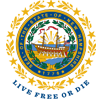Frequently Asked Questions
Frequently asked questions about FirstNet New Hampshire.
What is the First Responder Network Authority (FirstNet)?
FirstNet is an independent authority within the U.S. Department of Commerce's National Telecommunications and Information Administration. FirstNet is governed by a 15-member Board consisting of the Attorney General of the United States, the Secretary of Homeland Security, the Director of the Office of Management and Budget, and 12 members appointed by the Secretary of Commerce. The FirstNet Board is composed of representatives from public safety; local, state and federal government; and the wireless industry.
Signed into law on February 22, 2012, the Middle Class Tax Relief and Job Creation Act created FirstNet. The law gives FirstNet the duty to ensure the building, deployment, and operation of the first nationwide public safety broadband network. FirstNet will provide a single interoperable platform for public safety communications.
What is the Nationwide Public Safety Broadband Network (NPSBN)?
Mandated through Federal legislation, the Nationwide Public Safety Broadband Network (NPSBN) is an interoperable nationwide high speed broadband network dedicated to public safety that is capable of withstanding natural and man-made disasters.
Who will be allowed to access the network?
The network is dedicated to public safety. Entities that support public safety – such as utility companies and transportation entities – will be able to access the network as part of their public safety support mission.
How will the network support public safety responders?
The network will provide public safety responders with prioritized, real-time access to their mission-critical data during incident response. Currently, public safety agencies do not have prioritized access on commericial networks. As was the case during the 2013 Boston Marathon bombing, commercial networks can become over-saturated during major incidents limiting public safety's ability to access data. The NPSBN will also increase access to bandwidth that is capable of running sophisticated data applications, such as streaming video, geo-spatial applications, telemetry, computer-aided dispatch (CAD) access, mobile field reporting, etc.
Who will build the network and when will it be available?
FirstNet is charged with overseeing the construction of the network. FirstNet possesses the license to the 20 MHz of radio spectrum that has been dedicated to the network, and FirstNet owns the network core. The radio access network (RAN) portion of the network – consisting of all of the communication sites (e.g., towers) and the radio and data transportation components associated with them – will be built by FirstNet. All 50 states, five U.S. territories and Washington, D.C. have "opted in" to FirstNet, meaning each has accepted its individual State Plan detailing how the network will be deployed in their state/territory. FirstNet has until 2022 to build out the network.
Will the NPSBN replace my public safety land mobile radio (LMR) system?
No. While there will be voice communication capability with the NPSBN when it is introduced, it will not be public safety communications "mission critical" quality. Mission-critical communications include capabilities such as point to multi-point communication, and device-to-device direct communication when not connected to a network. These capabilities are not yet part of the selected long term evolution (LTE) technology platform. It is not anticipated that the network will have mission-critical communications capabilities for the foreseeable future, so existing public safety LMR systems must continue to be maintained. The NPSBN will supplement LMR communications for access to mission-critical data.
Why Long Term Evolution (LTE)?
Long Term Evolution (LTE) is a fourth-generation (4G) wireless technology that bases its operating standards on the Internet Protocol (IP). IP-enabled networks and wireless devices provide higher capacity and transmission speeds than earlier technologies. LTE allow devices to send and receive non-voice data, such as images and video. The law that established FirstNet specified that the network shall be based on the minimum technical requirements on the commercial standards for LTE service.
For public safety communications, LTE will have a significant impact. It is being planned to augment, and not replace, existing mission-critical voice networks such as LMR. A future generation of public safety LTE technology could possibly also include voice.
Will I have to use the network?
No. There is absolutely no mandate for any agency to adopt and utilize the network.
How much is the subscription cost and will it be per user or per device?
The State of New Hampshire contract is available online.
Who is planning the network within the state, and what will my agency need to provide?
The New Hampshire Statewide Interoperability Coordinator (SWIC) has been designated by the governor as the Single Point of Contact (SPOC) for the planning effort in the state. The SWIC worked in conjunction with the Statewide Interoperability Executive Committee (SIEC) to gather all of the network requirements from the New Hampshire public safety community. Initial data was submitted to FirstNet in October 2015. A finalized data submission report was sent to FirstNet in June 2016. FirstNet had an established deadline of September 30th, 2016 for data submission for consideration in the development of the New Hampshire network deployment plan.
How can my city or county participate in the development of the FirstNet network?
FirstNet is responsible for working through the designated state Single Points of Contact (SPOC) to consult with states, local communities, tribal governments, and first responders to gather requirements for developing its network deployment plans. Elected officials may provide input to FirstNet via the outreach efforts being coordinated by the SPOC in each state and through future proposed rulemaking processes that will take place.
Elected officials may also want to contact members of the FirstNet Public Safety Advisory Committee (PSAC). PSAC members represent associations whose memberships are comprised of local, state, and tribal entities. More information regarding the PSAC and its membership is available on the website.
Who will be responsible for operating and managing the network in my city or county?
FirstNet will be responsible for managing core operations and RAN operations. FirstNet also will enable robust identity management and authentication practices at the local level.




